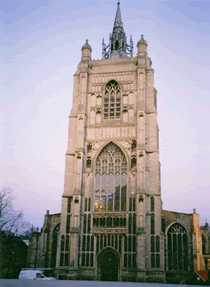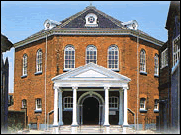You are here: Home > Old Norwich > Churches
Old Norwich - Churches
Medieval Norwich had 57 churches within the city walls, and 31 still exist. Most are perpendicular in style and are skilfully built of local flint.

St Peter Mancroft (left) is the largest church in Norwich and is sometimes mistaken for the Cathedral by visitors. Built between 1430 and 1455, it stands at one side of the market place, its massive tower presiding over the very centre of the city. The wide expanse of roof covers both the nave and chancel and is topped with lead. Norwich has a long tradition of bell ringing and it was in St Peter Mancroft that the first true peal of 5,040 changes was rung in 1715.
St Peter Mancroft is by common consent regarded as one of the finest medieval parish churches in England, and a 'must see' for all visitors to Norwich. Its unusual second name is thought to derive from 'Magna Crofter', the Latin for 'great field'.
The colourful 15th century cast window of St Peter Mancroft, although badly damaged by an explosion during the English Civil War, is still one of the marvels of Norwich.
St Andrew's is the second largest church in the city. It stands slightly above St Andrew's Street and is one of the finest examples of East Anglian ecclesiastical architecture. The Suckling Chapel, on its north side, has beautifully carved monuments to Robert Suckling, mayor in 1572 and 1582, to his son, Sir John Suckling, Secretary of State to James 1 and Charles 1, and to Sir John's wife, Martha, who died in 1613.
St Giles, on the north side of St Giles Street, has the tallest parish church tower in Norwich. The tower rises over 120 ft (36m) from the highest ground in Norwich, dominating the river valley to the north and the western approach to the city. There are interesting brasses and wall monuments, some of which commemorate the wealthy medical men who lived in the fine Georgian houses on St Giles Street.
St Julian's in St Julian's Alley, between Rouen Road and King Street, was almost entirely rebuilt after being destroyed by wartime bombing. St Julian's was the site of the cell of the 14th-century anchoress, Mother Julian of Norwich, author of the mystical book Revelations of Divine Love.
At the end of an alleyway off Colegate stands the Old Meeting House, which was built in 1693 by prominent Norwich Nonconformists. Its red-brick south front is attractively symmetrical, with two rows of sash windows, which are said to be the earliest in Norwich. The interior is impressively plain, with galleries on three sides looking down on curving rows of pews and a tall pulpit. The Old Meeting House is still used occasionally for services.
 In the 18th century, when the weaving trade was thriving, several wealthy
textile manufacturers made their homes in Colegate. Their elegant houses faced
the street, with gardens and coach houses behind. The Octagon (top-left) was
built to replace a Presbyterian chapel, which had been hidden from the road.
The new chapel was given a wide entrance with great carriage gates by its
architect, Thomas ivory, who was also responsible for the design of the Assembly
House. The Octagon is a brick building with arched sash windows and an elegant
portico. Inside the chapel, a ring of Corinthian columns is linked by galleries
and at their tops by arches. Rows of pews rise in tiers in the central floor
area, and underneath and upon the galleries. The Octagon has been a Unitarian
chapel since the beginning of the 19th century.
In the 18th century, when the weaving trade was thriving, several wealthy
textile manufacturers made their homes in Colegate. Their elegant houses faced
the street, with gardens and coach houses behind. The Octagon (top-left) was
built to replace a Presbyterian chapel, which had been hidden from the road.
The new chapel was given a wide entrance with great carriage gates by its
architect, Thomas ivory, who was also responsible for the design of the Assembly
House. The Octagon is a brick building with arched sash windows and an elegant
portico. Inside the chapel, a ring of Corinthian columns is linked by galleries
and at their tops by arches. Rows of pews rise in tiers in the central floor
area, and underneath and upon the galleries. The Octagon has been a Unitarian
chapel since the beginning of the 19th century.
Only ten of the city's medieval churches are now used for worship, and in recent years many have been found alternative uses. The Norwich Historic Churches Trust cares for 17 redundant medieval churches, 16 of which are now used for other purposes (including other Christian activities, but also as arts venues, antiques markets and even a 'hands on' science centre).
